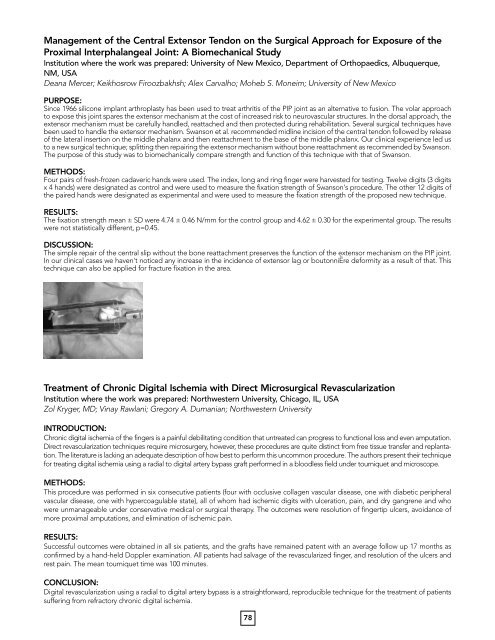Floor plan - 2013 Annual Meeting - American Association for Hand ...
Floor plan - 2013 Annual Meeting - American Association for Hand ...
Floor plan - 2013 Annual Meeting - American Association for Hand ...
Create successful ePaper yourself
Turn your PDF publications into a flip-book with our unique Google optimized e-Paper software.
Management of the Central Extensor Tendon on the Surgical Approach <strong>for</strong> Exposure of the<br />
Proximal Interphalangeal Joint: A Biomechanical Study<br />
Institution where the work was prepared: University of New Mexico, Department of Orthopaedics, Albuquerque,<br />
NM, USA<br />
Deana Mercer; Keikhosrow Firoozbakhsh; Alex Carvalho; Moheb S. Moneim; University of New Mexico<br />
PURPOSE:<br />
Since 1966 silicone im<strong>plan</strong>t arthroplasty has been used to treat arthritis of the PIP joint as an alternative to fusion. The volar approach<br />
to expose this joint spares the extensor mechanism at the cost of increased risk to neurovascular structures. In the dorsal approach, the<br />
extensor mechanism must be carefully handled, reattached and then protected during rehabilitation. Several surgical techniques have<br />
been used to handle the extensor mechanism. Swanson et al. recommended midline incision of the central tendon followed by release<br />
of the lateral insertion on the middle phalanx and then reattachment to the base of the middle phalanx. Our clinical experience led us<br />
to a new surgical technique; splitting then repairing the extensor mechanism without bone reattachment as recommended by Swanson.<br />
The purpose of this study was to biomechanically compare strength and function of this technique with that of Swanson.<br />
METHODS:<br />
Four pairs of fresh-frozen cadaveric hands were used. The index, long and ring finger were harvested <strong>for</strong> testing. Twelve digits (3 digits<br />
x 4 hands) were designated as control and were used to measure the fixation strength of Swanson's procedure. The other 12 digits of<br />
the paired hands were designated as experimental and were used to measure the fixation strength of the proposed new technique.<br />
RESULTS:<br />
The fixation strength mean ± SD were 4.74 ± 0.46 N/mm <strong>for</strong> the control group and 4.62 ± 0.30 <strong>for</strong> the experimental group. The results<br />
were not statistically different, p=0.45.<br />
DISCUSSION:<br />
The simple repair of the central slip without the bone reattachment preserves the function of the extensor mechanism on the PIP joint.<br />
In our clinical cases we haven't noticed any increase in the incidence of extensor lag or boutonniËre de<strong>for</strong>mity as a result of that. This<br />
technique can also be applied <strong>for</strong> fracture fixation in the area.<br />
Treatment of Chronic Digital Ischemia with Direct Microsurgical Revascularization<br />
Institution where the work was prepared: Northwestern University, Chicago, IL, USA<br />
Zol Kryger, MD; Vinay Rawlani; Gregory A. Dumanian; Northwestern University<br />
INTRODUCTION:<br />
Chronic digital ischemia of the fingers is a painful debilitating condition that untreated can progress to functional loss and even amputation.<br />
Direct revascularization techniques require microsurgery, however, these procedures are quite distinct from free tissue transfer and re<strong>plan</strong>tation.<br />
The literature is lacking an adequate description of how best to per<strong>for</strong>m this uncommon procedure. The authors present their technique<br />
<strong>for</strong> treating digital ischemia using a radial to digital artery bypass graft per<strong>for</strong>med in a bloodless field under tourniquet and microscope.<br />
METHODS:<br />
This procedure was per<strong>for</strong>med in six consecutive patients (four with occlusive collagen vascular disease, one with diabetic peripheral<br />
vascular disease, one with hypercoagulable state), all of whom had ischemic digits with ulceration, pain, and dry gangrene and who<br />
were unmanageable under conservative medical or surgical therapy. The outcomes were resolution of fingertip ulcers, avoidance of<br />
more proximal amputations, and elimination of ischemic pain.<br />
RESULTS:<br />
Successful outcomes were obtained in all six patients, and the grafts have remained patent with an average follow up 17 months as<br />
confirmed by a hand-held Doppler examination. All patients had salvage of the revascularized finger, and resolution of the ulcers and<br />
rest pain. The mean tourniquet time was 100 minutes.<br />
CONCLUSION:<br />
Digital revascularization using a radial to digital artery bypass is a straight<strong>for</strong>ward, reproducible technique <strong>for</strong> the treatment of patients<br />
suffering from refractory chronic digital ischemia.<br />
78



